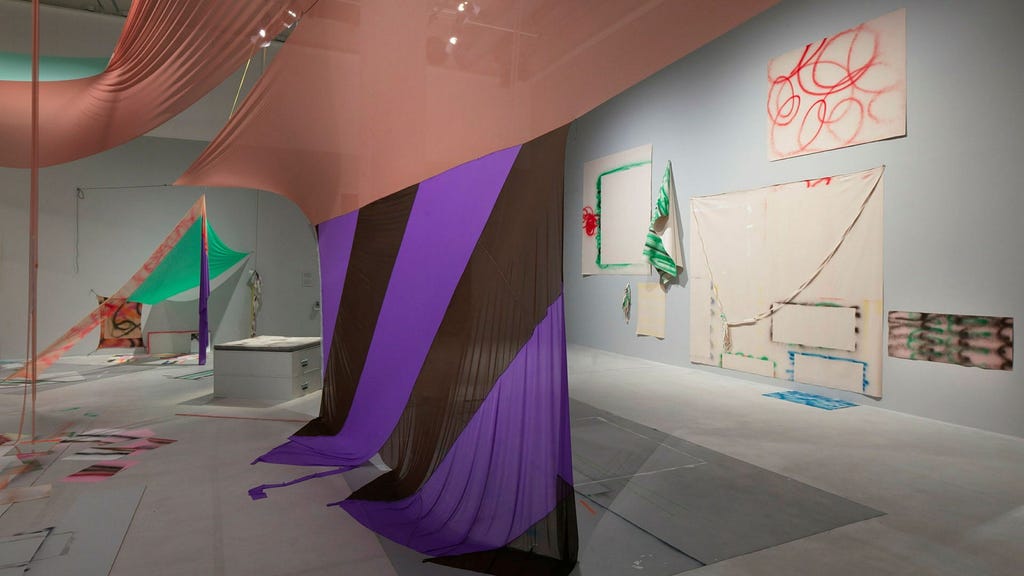Anna Nyberg’s exhibition, ”Blicken glider isär” (The Gaze Slips Apart), at Västerås Art Museum, housed in the former Asea Mimer workshop from the 1910s, presents a captivating interplay of textures, colors, and spatial arrangements. The title aptly reflects the visitor’s experience within the vast industrial space, where the eye is constantly drawn to new elements, darting between stretched fabrics, loosely hanging ribbons, sprayed paper sheets, video screens, and mirrors on the floor. Nyberg’s sprawling installation crisscrosses the room, creating a dynamic environment with constantly shifting perspectives that guide both the eye and the body through the exhibition.
Certain elements within the experimental composition stand out, like the unexpected juxtaposition of a folded rubber mattress and a piece of fabric marked with green spray paint. Although seemingly arbitrary, these combinations feel surprisingly natural within the larger context of the installation. Nyberg utilizes thin, elastic chiffon, stitching it together in contrasting striped color fields and stretching it taut. Pistachio green meets creamy beige, lilac contrasts with reddish-brown, punctuated by bright yellow and red accents. This vibrant palette and geometric arrangement evoke the work of Olle Bærtling, particularly his textile draperies and flags, although Nyberg’s work exists in a three-dimensional realm.
The exhibition’s lighting, unfortunately, diminishes the intended sense of movement within the artwork, lending a somewhat static, museum-like quality to the dynamic installation. Nyberg’s artistic exploration shares similarities with Katharina Grosse’s expansive color explosions and Vivian Suter’s freely hanging, moisture-laden canvases. While Grosse’s work often encompasses entire architectural structures, transforming them into vibrant canvases, and Suter’s emphasizes the organic process of creation through natural weathering and decay, Nyberg’s work focuses on the interplay of color, texture, and form within a defined space, inviting viewers to navigate and interpret the evolving visual narrative.
Nyberg’s approach to three-dimensional painting showcases a significant dynamism and, by Swedish standards, unusually grand gestures. She has extensively documented this project in her intricate artist’s book, ”När rummet är bilden” (When the Room is the Image), and will further develop these concepts during an upcoming artist residency in Brooklyn. Her exploration expands upon the established field of large-scale installations, pushing the boundaries of painting beyond the traditional canvas and into the realm of spatial intervention. This allows for a more immersive and interactive experience, engaging the viewer not only visually but also physically as they navigate the installation.
Further enriching the experience at Västerås Art Museum is the inclusion of Miriam Bäckström’s jacquard weave, ”Concentric II,” from the museum’s collection. Positioned strategically in the opening between the exhibition halls, the circular form immediately captures attention. The iridescent color effect, drawing the eye towards the center of the weave, establishes a compelling contrast to Nyberg’s spatial expansion. Bäckström’s work offers a counterpoint to Nyberg’s expansive installation – a focal point of concentrated color and texture within the larger context of the museum space. This juxtaposition highlights the diversity within contemporary art practices, showcasing both expansive and intensely focused approaches to material and form.
The stark contrast between Nyberg’s expansive spatial composition and Bäckström’s intricate material density creates a dynamic tension. This juxtaposition underscores the compelling interplay between opposing artistic approaches. The museum’s presentation effectively captures this tension, offering viewers a rich and multifaceted artistic experience that encourages reflection on the diverse ways in which artists engage with space, color, and materiality. The pairing of these two artists provides a thought-provoking dialogue on the nature of artistic creation, the exploration of materiality, and the manipulation of space and perception.














